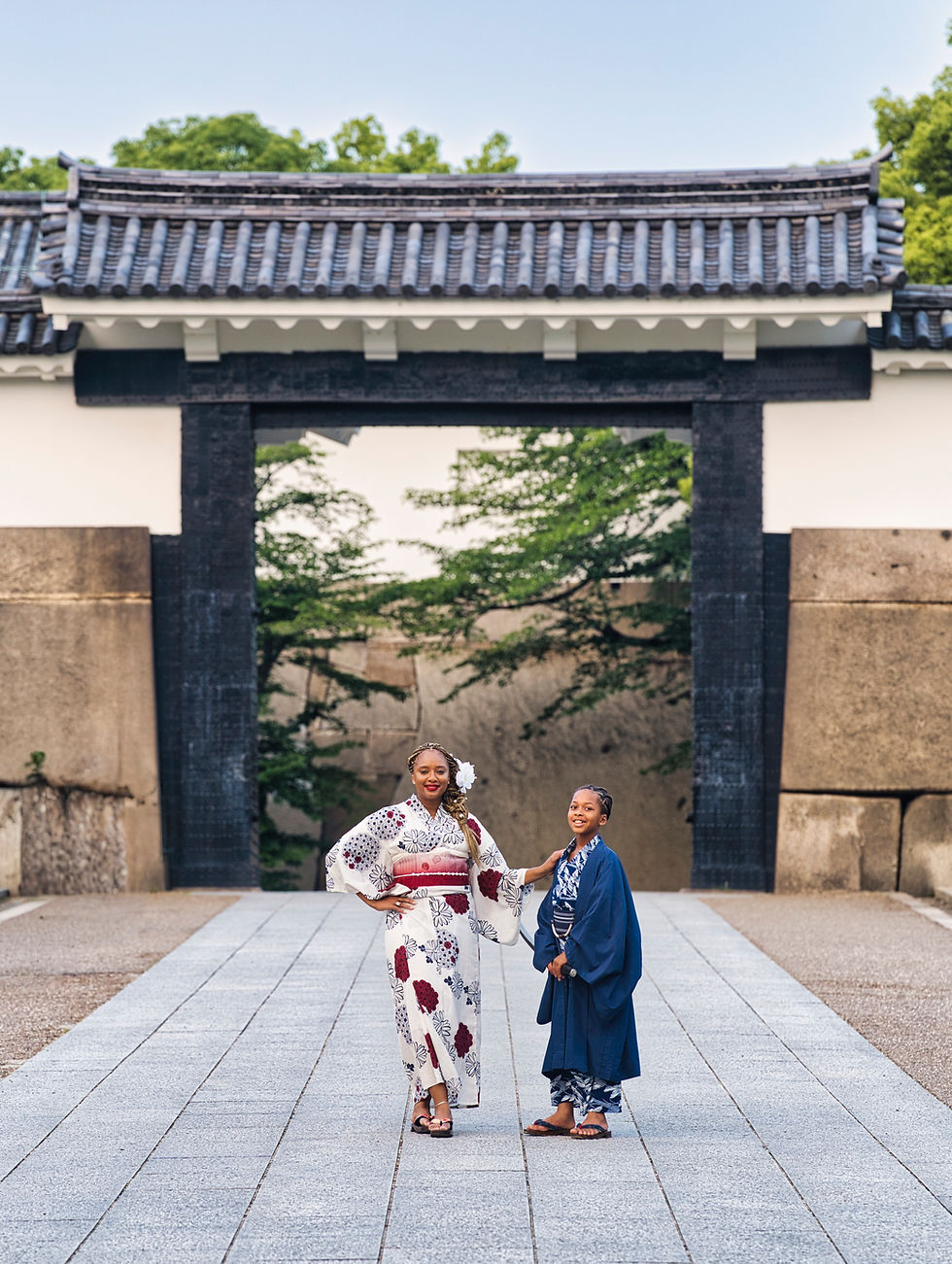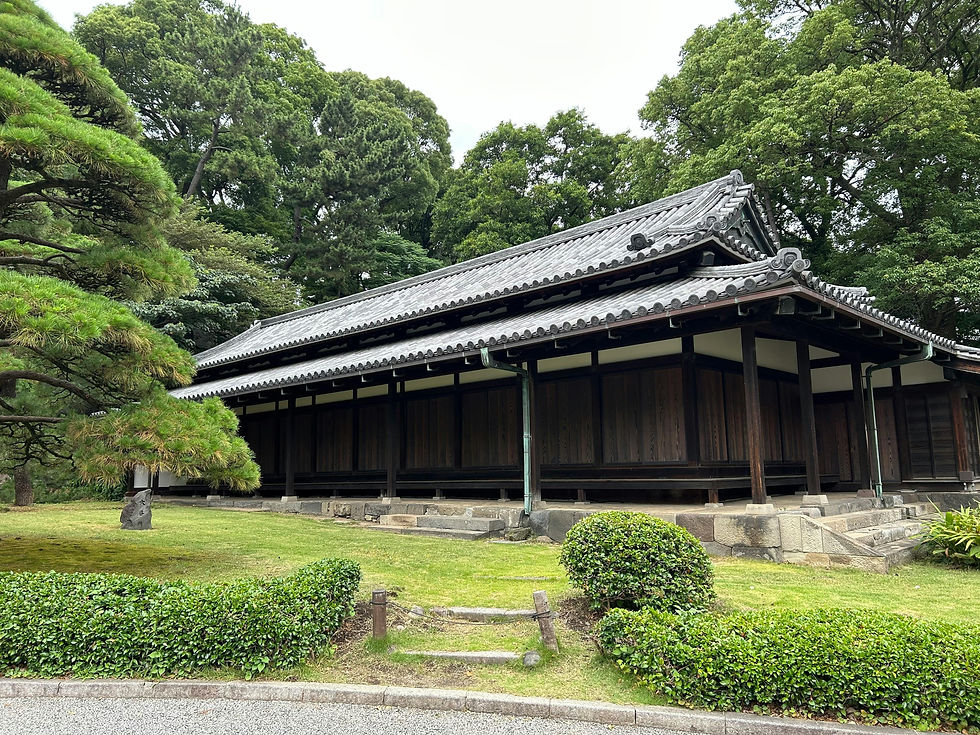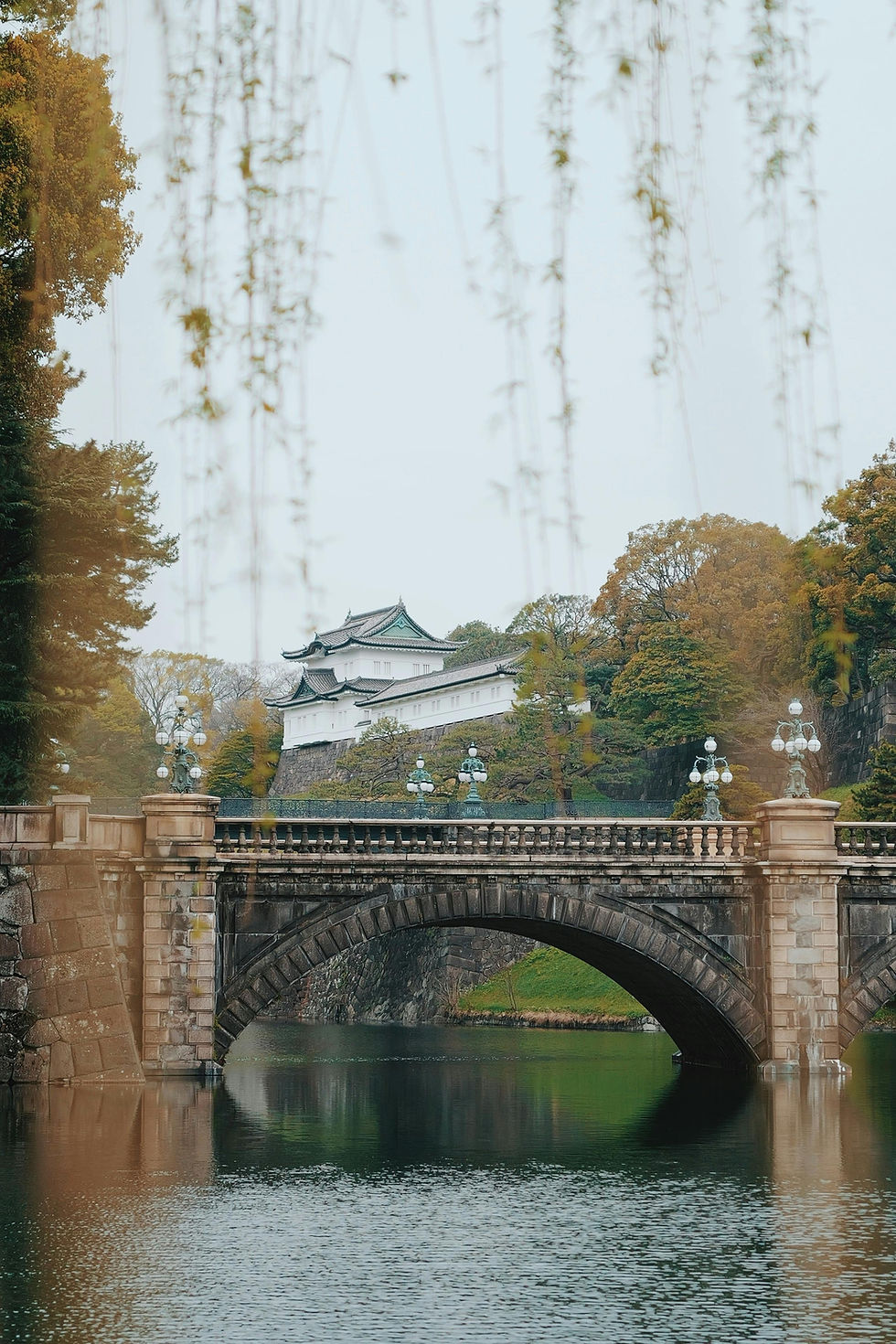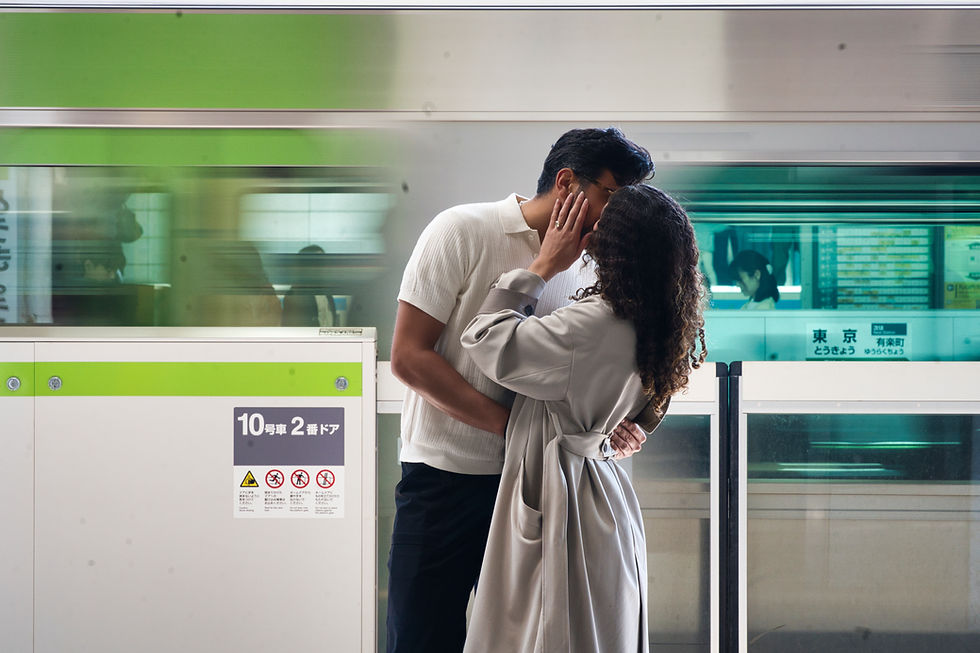Documenting the Changing Seasons at Tokyo's Imperial Palace
- parlindunganchrist
- Sep 9
- 12 min read
Updated: Oct 8
What makes the East Gardens of Tokyo Imperial Palace perfect for seasonal photography sessions in Tokyo?
The East Gardens of Tokyo Imperial Palace are a sanctuary where history and natural beauty intertwine, offering an exceptional backdrop for photography sessions in Tokyo. Located on the former grounds of Edo Castle, the gardens feature moats, stone walls, and wide lawns that add layers of storytelling to every photo. For photographers shooting with Sony cameras, the gardens provide opportunities to experiment with natural light and sharp architectural details. This blend of heritage and seasonal change makes the gardens a must-visit for families, couples, and travelers seeking timeless portraits.
Each season in the East Gardens transforms the scenery into a living canvas. In spring, cherry blossoms and plum trees bloom along carefully maintained paths, while the iris garden bursts into color by early summer. Families in kimono often schedule photo sessions in Tokyo here to capture these fleeting blooms. Sony shooters benefit from capturing blossoms in soft morning light, which adds a creamy bokeh effect when paired with prime portrait lenses.

During summer, lush greenery creates a soothing palette perfect for candid portraits and family photography. Wide lawns allow children to play freely while photographers compose shots that balance movement and stillness. Using a Sony mirrorless camera, high-speed continuous shooting can freeze laughter and action without losing clarity. Summer mornings in the East Gardens are less crowded, which helps create intimate moments despite being in central Tokyo.
In autumn, Ninomaru Grove becomes the centerpiece of the East Gardens with a vibrant mix of red maples and golden ginkgo trees. This season is especially popular for family photo sessions in Japan, as many families book kimono rentals to match the warm autumn tones. Photographers can enhance depth by layering foreground leaves against background structures like castle ruins or gates.
Winter may seem quiet, but it brings a subtle elegance to the gardens. Bare branches and muted light allow for more dramatic portraits that emphasize emotion over color. Low winter sunlight is flattering for portraits, especially during golden hour when warm tones highlight the stone walls. Sony shooters can use wide-aperture lenses to maximize available light, creating soft and atmospheric winter family portraits.
Accessibility adds to the appeal. The East Gardens are free to enter and open most days of the year, with entrances such as Otemon Gate and Hirakawamon Gate. Hours shift seasonally, so photographers should always check the Imperial Household Agency’s official website before planning a session. For families traveling to Tokyo, the gardens offer a balance of cultural heritage and natural landscapes without additional cost.
In conclusion, the East Gardens’ seasonal transformations, historic remnants, and easy access make them one of the best locations for photography sessions in Tokyo. Whether planning a kimono photo session in Tokyo or a playful family photo session in Japan, the gardens promise timeless portraits framed by centuries of history.
When is the ideal time to schedule photography sessions at Chidorigafuchi moat, especially cherry blossom photo sessions in Tokyo?
Chidorigafuchi is globally celebrated as one of the most spectacular spots for cherry blossom photo sessions in Tokyo. Stretching along the northwestern moat of the Imperial Palace, this 700-meter walkway becomes a pink tunnel each spring. Families often dress in kimono and book photo sessions in Japan to capture blossoms cascading over the calm waters. Sony shooters find endless creative opportunities here, from daytime candids under blossoms to evening shots illuminated by lanterns. Knowing exactly when to go makes the difference between average snapshots and breathtaking portraits:
Peak bloom late March–early April is the most popular time; forecasts are updated yearly by Japan Meteorological Agency.
Evening “yozakura” light-ups create glowing reflections—ideal for long-exposure Sony shots.
Blue hour after sunset enhances sky contrasts, perfect for couple or kimono sessions.
Morning visits on weekdays reduce crowds, allowing smoother family photo sessions.
Boat rentals on the moat give photographers unique low angles with blossoms above.
For dreamy kimono photo sessions in Tokyo, aim for a weekday evening during full bloom.
How can autumn ginkgo foliage along the moat be used for stunning photography sessions in Tokyo Imperial Palace?
By late November, the Imperial Palace’s moats are lined with glowing ginkgo trees that blanket pathways in golden hues. This season is less crowded than cherry blossom season, making it ideal for photography sessions in Tokyo. Families love scheduling family photo sessions in Japan here, as children can interact naturally with fallen leaves while photographers capture candid joy.
The vibrant yellow contrasts beautifully with stone walls and water reflections. Sony shooters can use wide apertures to create creamy bokeh with ginkgo leaves in the foreground, framing subjects in traditional attire. For families wearing kimono, the golden tones harmonize perfectly with classic patterns, elevating the cultural feel of each portrait.
Golden hour is particularly magical in autumn. The sunlight filters through ginkgo canopies, adding warmth and texture to portraits. Photographers shooting with Sony cameras can use HDR modes to balance the glowing trees with softly lit faces, ensuring balanced exposure in challenging light.
Composition ideas include leading lines along the ginkgo avenue, capturing reflections in the water moat, and using bridges or gates as strong architectural anchors. Internally, link to your “Top autumn photo spots in Tokyo” to guide readers further.
Unlike spring crowds, autumn allows photographers to slow down and experiment with angles. Longer exposure shots can capture leaf movement in the wind, while still portraits highlight serene beauty. Sony’s stabilization features make handheld shots easier even in lower autumn light.
Ultimately, the golden ginkgo foliage creates a nostalgic atmosphere that feels both modern and timeless. For families seeking a kimono family photo session in Japan, autumn at the Imperial Palace offers elegance, tradition, and breathtaking natural beauty.
What winter lighting opportunities make the Imperial Palace ideal for low-light family photo sessions in Japan?
While many travelers overlook winter, it is one of the most underrated seasons for family photo sessions in Japan. The Imperial Palace takes on a quiet dignity, with subtle illumination of moats, bridges, and stone gates. These lighting opportunities allow Sony shooters to capture moody, cinematic portraits that contrast with the vibrancy of spring or autumn. The crisp winter air creates cleaner skies and sharper reflections, enhancing both daytime and nighttime sessions.
Key gates and bridges are illuminated in winter evenings—check Japan Guide for seasonal hours.
Sony’s low-light sensors allow handheld portraits even without tripods.
Use reflective moats to capture glowing city lights mirrored in the water.
Experiment with silhouettes under lantern-lit walkways for creative storytelling.
Plan golden hour sessions when soft winter sun enhances skin tones.
Winter highlights intimacy and warmth in portraits. Internally, link to “Sony low-light photography tips for Tokyo sessions.
Can photographers shooting with Sony cameras capture reflection shots of Tokyo’s skyline at Imperial Palace moats?
The moats around the Imperial Palace are more than defensive relics, they’re reflective canvases for photographers. As Tokyo’s skyline rises behind ancient walls, still water mirrors both tradition and modernity. For a photographer shooting with Sony, reflections become a playground of symmetry, light, and perspective.
Families or couples booking photography sessions in Tokyo often request reflective compositions to symbolize balance. Twilight and evening are ideal times, when warm artificial lights contrast with the cool tones of the moat. Planning such sessions requires patience, timing, and the right camera settings.
Visit during calm weather for glass-like reflections.
Use wide lenses to maximize symmetry or telephoto for detail.
Lower your shooting angle close to the water.
Reflection photography is not just technical; it’s emotional. By placing a family or couple near the moat, you create double-layered portraits that show both subject and mirrored world. This duality tells a story of identity and place, making it especially meaningful for travelers.
Sony shooters benefit from excellent autofocus in low light, ensuring crisp reflections without sacrificing subject sharpness. A fast prime lens (like 35mm f/1.4) works beautifully for portraits, while wide zooms capture skyline breadth.
Reflections also allow playful experimentation: capturing fallen leaves floating on the water, or using the rippling effect to add abstraction. For families in kimono, reflections highlight cultural beauty framed by nature and architecture.
To plan effectively, check the Chiyoda tourism site for moat access points and illumination schedules. Combining cultural attire, family storytelling, and urban landscapes makes reflection photography at the Imperial Palace unforgettable.
How does visiting during golden hour enhance family photo sessions in Japan at the Imperial Palace?
Golden hour, the magical time just after sunrise or before sunset, is one of the most sought-after moments for family photo sessions in Japan. At the Imperial Palace in Tokyo, the combination of golden light, seasonal flowers, and reflective moats creates breathtaking backgrounds for timeless portraits. Families wearing kimono or coordinated outfits look especially radiant when bathed in this soft glow. As a professional photographer shooting with Sony cameras, I find that golden hour elevates colors, adds depth to shadows, and highlights every smile with warmth. This natural lighting transforms ordinary moments into extraordinary memories.
Soft Light for Skin Tones → Golden hour reduces harsh shadows, making family photo sessions in Tokyo more flattering.
Enhanced Seasonal Colors → Cherry blossoms, autumn ginkgo leaves, or even winter branches glow with rich tones.
Reflective Surfaces → The Imperial Palace moats mirror the skyline, creating layered compositions.
Perfect Timing → Sunset near Chidorigafuchi or sunrise at Otemon Gate offers iconic backdrops.
Sony Camera Advantage → Wide-aperture lenses (f/1.8 or f/2.8) capture stunning bokeh in low light.
Golden hour at the Imperial Palace is more than just light. It’s atmosphere, emotion, and storytelling combined. Families who choose this time for photography sessions in Tokyo always walk away with images full of warmth and authenticity.

What are the photography etiquette rules especially for Sony shooters around the Tokyo Imperial Palace grounds?
The Imperial Palace is not just a popular photography location, but also a cultural and historical landmark. With thousands of visitors daily, maintaining respect for both the space and its traditions is vital. Family photo sessions in Japan are highly cherished, but photographers must balance creativity with courtesy. As someone who often photographs here with Sony gear, I’ve learned that etiquette ensures smoother sessions and keeps the Imperial Palace welcoming for all.
At times, tourists and professional photographers unintentionally disrupt the experience by setting up large equipment or crossing restricted zones. However, following a few clear guidelines can make the session enjoyable, professional, and respectful. Understanding the do’s and don’ts is just as important as knowing the right camera settings.
No Tripods in Crowded Areas → Large equipment is restricted to avoid blocking pathways.
No Commercial Filming → Filming for commercial purposes requires special permission.
Respect Restricted Zones → Certain gates and bridges are closed to the public.
Observing these rules doesn’t limit creativity instead, it enhances the challenge of capturing authentic moments. Using a lightweight Sony camera body with a fast lens allows photographers to adapt quickly without needing bulky setups. Handheld techniques and natural light can still produce professional-quality results.
Professionalism also means ensuring families feel comfortable. Many Japanese visitors value privacy, so it’s important to ask before including strangers in your frame. This adds to the trust and rapport between the photographer and the client.
Respecting etiquette highlights your awareness of Japanese culture. It positions you not just as a photographer, but as a cultural ambassador who values the traditions of the location. This is especially meaningful for international clients seeking an authentic experience.
Ultimately, photography sessions in Tokyo’s Imperial Palace are most successful when artistry and etiquette coexist. Clients leave with stunning memories, and the reputation of photographers as respectful professionals continues to grow.
Is it possible to include kimono family photo sessions in Japan around the Imperial Palace during Shichi-Go-San in November?
Shichi-Go-San, celebrated every November, is one of Japan’s most cherished family traditions. During this festival, children aged three, five, and seven are dressed in beautiful kimono and taken to shrines for blessings. For many families, it is also the perfect time to schedule kimono family photo sessions in Japan. The Imperial Palace grounds, surrounded by autumn foliage, become a symbolic and visually stunning setting for these treasured portraits.
The cultural significance of this celebration makes it especially meaningful for photography. Wearing traditional kimono near the historic Imperial Palace combines elegance with a sense of continuity between Japan’s history and modern family life. The vibrant ginkgo leaves along the moat create a golden backdrop, enhancing the festive mood of Shichi-Go-San.
From a photography perspective, November provides soft autumn light that enhances textures and colors. Families walking together in kimono capture a timeless scene, and the palace grounds allow for a variety of compositions from wide shots with Nijubashi Bridge to intimate portraits by the gardens. Sony cameras, with their dynamic range, capture both the details of the kimono patterns and the warm tones of fall leaves.
Practical considerations are important as well. Since November is a popular season for both tourism and cultural celebrations, photographers should plan sessions in advance. Arriving early in the day ensures less crowded backgrounds and a more relaxed atmosphere. Many families also combine shrine visits with Imperial Palace photo stops to create a complete Shichi-Go-San experience.
Ultimately, kimono family photo sessions in Japan during Shichi-Go-San reflect both tradition and artistry. Families not only celebrate milestones but also preserve them in professional portraits. The Imperial Palace is one of the most fitting places for these sessions, blending history, beauty, and cultural pride into lasting memories.
What are the best perspectives for capturing Nijubashi Bridge and surrounding seasonal scenes with a Sony camera?
Nijubashi Bridge is perhaps the most photographed landmark of the Tokyo Imperial Palace. Its elegant arches and the reflection in the moat make it an icon for both tourists and professional photographers. Throughout the seasons, this location offers new perspectives: cherry blossoms in spring, lush greenery in summer, golden ginkgo in autumn, and serene reflections in winter. Capturing these variations with a Sony camera allows photographers to highlight both technical precision and seasonal storytelling.
Front View from Kokyo Gaien Plaza → Classic postcard angle with symmetrical composition.
Side Perspective from the Garden Path → Adds depth with water reflections and seasonal trees.
Close-Up with Sony Telephoto Lens → Focus on the bridge’s intricate stonework.
Seasonal Frames → Cherry blossoms in spring and autumn foliage framing the bridge.
Low Angle for Reflections → Using wide-angle lenses to capture mirrored arches in the moat.
By experimenting with different perspectives, photographers can showcase Nijubashi Bridge in countless ways. Sony’s versatility ensures that every seasonal change becomes a chance to tell a new story through the lens.
How can professional photographers plan kimono photo sessions in Tokyo near the Imperial Palace, are kimono rentals available nearby?
Kimono photo sessions in Tokyo are one of the most requested services by both local and international families. The Imperial Palace, located near Tokyo Station, is surrounded by rental shops and studios that provide full kimono packages. These packages often include hair styling, accessories, and assistance with dressing, making it convenient for families who want a seamless experience. Combining a kimono rental with a professional family photo session creates both an authentic cultural experience and a visual story worth cherishing.
Planning such sessions requires coordination, as kimono dressing can take time and may be affected by weather conditions. Photographers shooting with Sony cameras benefit from preparing versatile lenses to capture both wide palace backdrops and intimate family portraits. With preparation, kimono family photo sessions in Japan can be stress-free and deeply memorable.
Kimono rentals are available near Tokyo Station and around the Imperial Palace.
Packages often include hairstyling, makeup, and accessories.
Booking in advance ensures availability, especially during peak seasons.
Kimono family photo sessions in Japan go beyond fashion—they embody cultural heritage. Walking in traditional attire against the backdrop of the Imperial Palace provides families with a rare chance to merge history and personal storytelling. Children especially enjoy the novelty of wearing kimono, which adds energy and joy to every frame.
For photographers, this presents opportunities to blend portrait and lifestyle photography. Sony cameras capture the intricate textures of kimono fabric, from silk embroidery to vibrant patterns. Shooting near Nijubashi Bridge, Otemon Gate, or the East Gardens offers endless possibilities for stunning compositions.
Another benefit of choosing the Imperial Palace area is accessibility. With Tokyo Station just minutes away, families can transition smoothly from kimono rental shops to the palace grounds. This convenience is especially helpful for families with children, ensuring the experience feels celebratory rather than stressful.
Ultimately, planning kimono photo sessions in Tokyo near the Imperial Palace ensures families not only preserve memories but also connect with Japanese culture. With careful planning and professional execution, the combination of kimono attire and historic surroundings becomes a timeless treasure.
FAQ: Documenting the Changing Seasons at Tokyo’s Imperial Palace
When is the best season to photograph the Imperial Palace in Tokyo?
Spring (March–April) showcases cherry blossoms along East Gardens and Chidorigafuchi moat, while autumn (late October–November) brings vibrant ginkgo and maple reflections both seasons are highly searched for seasonal photography in Tokyo’s Imperial Palace.
What time of day offers the best light at the Imperial Palace?
Sunrise and sunset provide soft, moody lighting perfect for portraits and reflections, making dawn or dusk the most popular timing for photographers.
Do I need a permit or reservation to take photos at the Imperial Palace?
The East Gardens are open daily (except Mondays/Fridays), and no permit is required for casual photography. However, inner grounds (e.g. palace tours on Jan 2 and Feb 23) need advance registration.
Can families shoot photos in traditional attire (kimono) at the Imperial Palace?
Yes! The seasonal backdrops: cherry blossoms, autumn leaves, winter illumination combined with kimono attire are widely sought in searches and produce timeless portraits.
What are the best spots for seasonal portraits at the Palace?
Top popular areas include:
Chidorigafuchi moat during cherry blossom peak
Hibiya Moat with autumn ginkgo reflections
Nijubashi Bridge at dawn or duskThese are consistently recommended in photography guides. Tokyo in Pics
Are there crowd-free tips for Imperial Palace photo sessions?
Yes. Visiting early in the morning or late afternoon (especially during peak bloom) is highly recommended to avoid crowds this timing is frequent advice in Tokyo travel guides.
What accessibility and transit options are best for photographers?
The Palace is centrally located: ~10 minutes walk from Tokyo Station and nearby Subways (Chiyoda Line, Mita Line) to Kikyo-mon Gate. Easily reachable, making it ideal for tours and mobile photo gear.
Are night or winter illuminations available for photography?
During winter (typically in December), select gates and moats are illuminated creating dramatic low-light opportunities sought by photographers year-round.

Author Bio
Nacho (Sore de Nacho Photography) is a Tokyo-based photographer specializing in family portraits, seasonal storytelling, and cultural sessions at iconic Japan locations including the Imperial Palace. His style beautifully combines candid moments with elegant backdrops that reflect Tokyo’s changing seasons: Cherry blossoms in spring, golden ginkgo in autumn, snowy pathways in winter. Whether you're planning a kimono photo session in Tokyo or a family photography session in Japan, Nacho’s expertise ensures your experience is memorable, stress-free, and visually stunning.




Comments